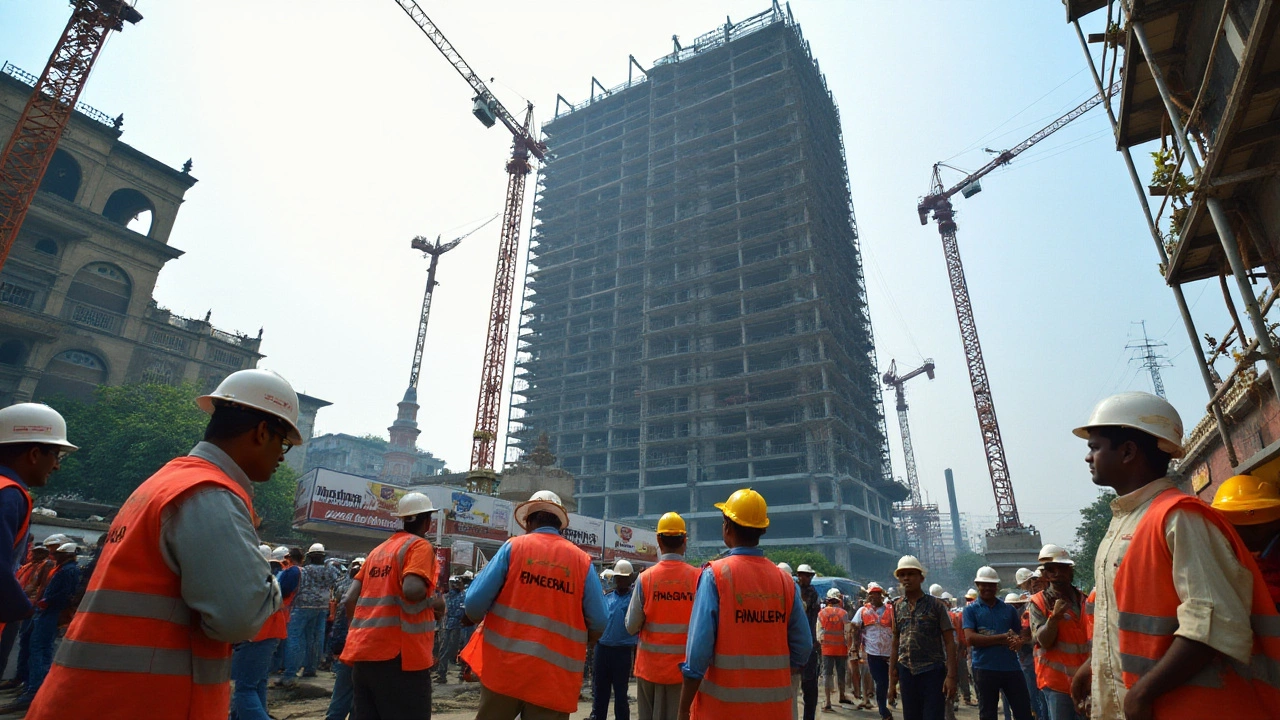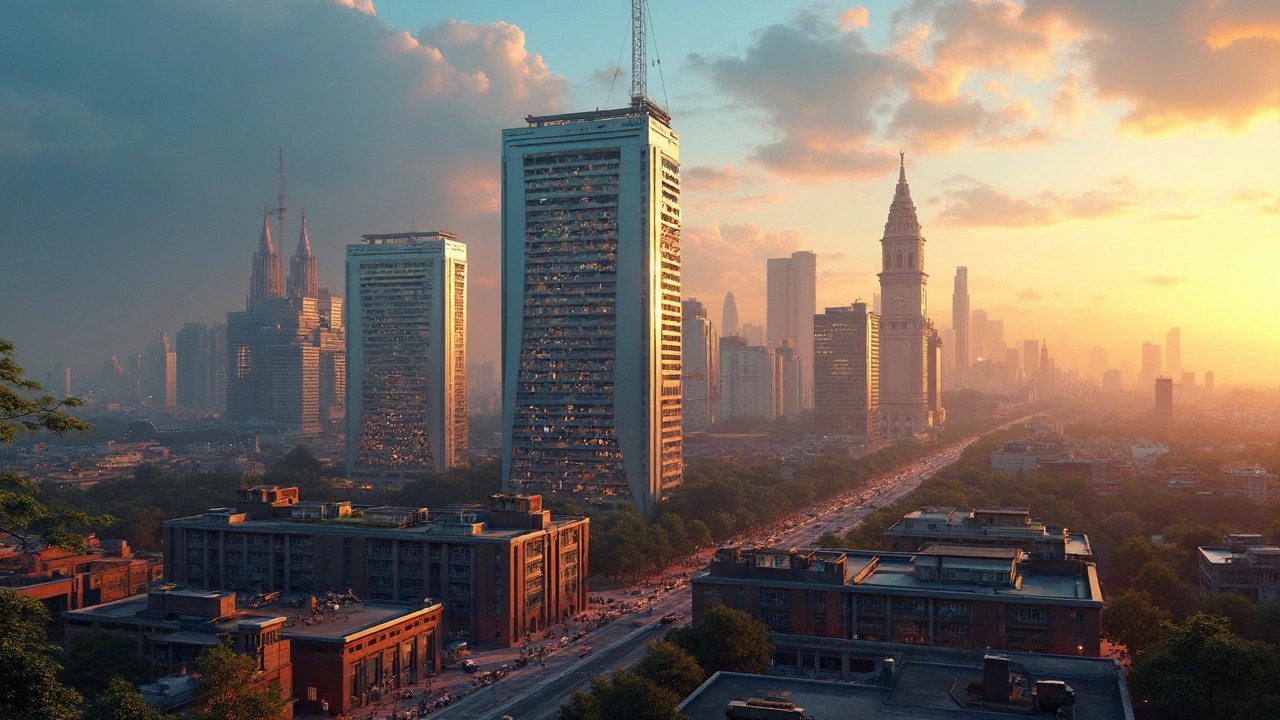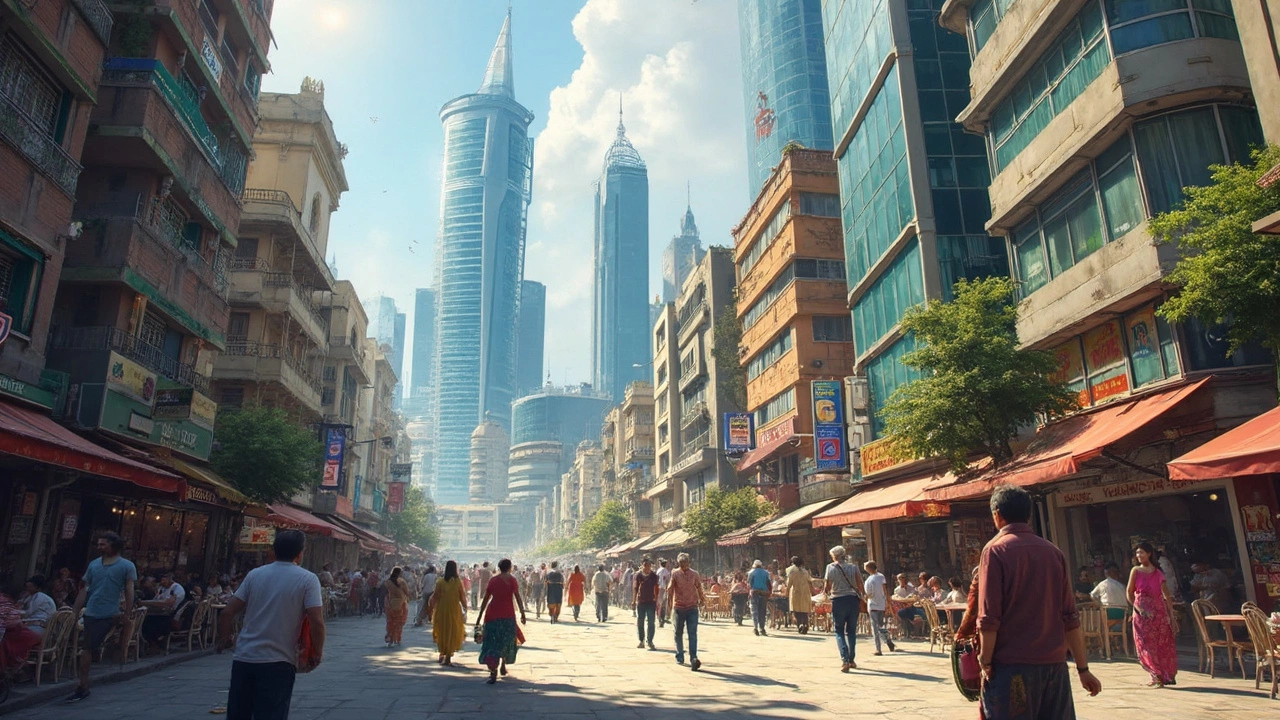Understanding Commercial Projects in Construction

In a world where commercial ventures shape the skyline, understanding the nuances of commercial construction projects becomes essential. These projects don't just create buildings; they craft venues bustling with life and enterprise. From towering office buildings to sprawling shopping centers, commercial construction serves as the backbone of business infrastructure.
The essence of commercial projects lies in their purpose—buildings tailored for commerce, whether retail, office spaces, or industrial units. It's not just about bricks and mortar; it's about designing spaces that efficiently align with the needs of businesses and the people who inhabit them.
Throughout history, commercial construction has played a vital role in urban development and economic growth. However, each project brings its own set of challenges and opportunities. As we step into the future, the industry continues to evolve, driven by technology, sustainability, and changing business models.
- Defining a Commercial Project
- Key Components of Commercial Construction
- Importance of Commercial Projects
- Challenges in Commercial Projects
- Future Trends in Commercial Construction
Defining a Commercial Project
At its core, a commercial project in the realm of construction is an undertaking that focuses on creating spaces intended primarily for business purposes. This includes the construction of office complexes, shopping centers, industrial facilities, and other buildings that house commercial activities. The term 'commercial' serves to distinguish these types of projects from residential or infrastructural developments, with the primary goal being to meet the needs of businesses and their clientele.
The anatomy of a commercial project often involves multiple phases, including planning, site selection, designing, obtaining permits, budgeting, and construction itself. The planning stage is pivotal as it sets the vision and scope of the project, ensuring alignment with both the client's demands and zoning regulations. During the design phase, architects and engineers collaborate to draft blueprints that focus on functionality, sustainability, and aesthetics, tailored to meet specific business operations. One can say that the blueprint is the 'soul' of a commercial project; once finalized, it guides the rest of the construction process.
Understanding the significance of commercial projects requires recognizing their impact on economic growth. These projects generate jobs, both during and after construction, they boost local economies by attracting new businesses and clientele. According to a report by the U.S. Census Bureau, new commercial building construction spending in the United States reached over $90 billion annually in recent years. Such statistics highlight the vital role commercial construction plays in fostering economic vitality.
Regulations play a crucial role in defining the framework within which commercial projects develop. Building codes, health and safety standards, and environmental compliance are non-negotiable elements. These regulations ensure that commercial buildings are safe and sustainable, reducing potential risks to occupants and the surrounding environment. Navigating these rules can be complex; however, they are essential for the longevity and legality of the finished structure. Often, developers collaborate with legal and environmental consultants to ensure adherence to all necessary standards.
In addition to understanding regulations, it is also essential to acknowledge the role of financing in commercial projects. Funding can come from a mix of sources including private investments, loans, and sometimes public incentives. Securing financial backing is not just about having capital, but also about having a credible plan that demonstrates potential for returns. Often, developers may stage various financial models to present to potential investors, showcasing expected cash flows and profit margins.
To encapsulate this holistic view of commercial projects, it might be insightful to consider the words of acclaimed architect Frank Lloyd Wright,
"The mother art is architecture. Without an architecture of our own we have no soul of our own civilization."Wright's sentiment reflects how commercial projects do not merely fill spaces with structures but shape the cultural and economic fabric of our society, mirroring its aspirations and needs.
Key Components of Commercial Construction
Commercial construction projects stand as remarkable feats of engineering and architecture, each demanding meticulous attention to detail and a synchronized choreography of various elements. To comprehend the vast landscape of commercial construction, one must first embark on a journey through its key components, which include planning and design, materials and technology, and project management. Beginning with planning and design, the blueprint of any commercial construction project lies in the vision of capable architects and developers who translate the conceptual ideas into tangible plans. These blueprints lay the foundation for the project's success, considering factors like site location, zoning laws, and the intended purpose of the structure. The design phase involves multiple iterations, ensuring that the plan is both functional and aesthetically pleasing.
The second critical element is the choice of materials and the implementation of technology. The advancement of building materials has allowed structures to reach greater heights while also enhancing durability and efficiency. From steel frameworks to eco-friendly concrete, selecting the right materials is crucial for the longevity and sustainability of construction projects. The incorporation of technology, such as Building Information Modeling (BIM), streamlines the construction process by allowing precise 3D representations of physical structures and efficient management of resources. "Technology has transformed the construction industry by enhancing accuracy and reducing overall costs," according to a report by the Construction Industry Institute.
Project management entwines all aspects of a commercial construct, acting as the linchpin that ensures timely delivery within budget. Effective project managers harmonize with a team of engineers, contractors, and stakeholders to coordinate timelines, budgets, and resource allocation. They demonstrate keen problem-solving skills, addressing any hurdles that emerge during the construction phase. Adhering to regulations and safety standards is non-negotiable, with rigorous inspections occurring at each stage of the process. The vitality of solid leadership echoes across the project's lifecycle, influencing its smooth completion.
Given the intricate processes and coordination involved in commercial building, understanding these key components also highlights common challenges that may arise. Weather conditions can pose unforeseen delays, while fluctuating material costs may affect budgeting. Thus, financial planning becomes a matter of utmost importance, supported by contingency plans to accommodate unexpected expenditures. The balance of quality, cost, and time lies at the heart of managing commercial construction projects, making the journey from planning to execution a complex yet fulfilling endeavor.
| Component | Importance |
|---|---|
| Planning & Design | Shapes the project; considers zoning and functionality. |
| Materials & Technology | Influences sustainability and resilience of the structure. |
| Project Management | Coordinates all elements to meet timelines and budgets. |

Importance of Commercial Projects
Commercial construction plays a pivotal role in shaping the economic landscape of a community. These projects elevate the commercial capacity by providing the necessary infrastructure that supports businesses and industries. One of the most compelling aspects is their ability to drive economic growth. Constructing commercial buildings boosts local economies through job creation, both directly during the construction phase and indirectly by facilitating business operations. When we see a new office tower or a refurbished shopping mall, we're looking at potential ripple effects that range from increased employment to enhanced community services sourced by generated revenue.
Moreover, commercial projects are foundational to urban development. Cities evolve around hubs of activity that commercial spaces provide. They stimulate the development of supporting infrastructure such as roads, public transportation, and utilities. This development often leads to an improvement in the quality of life for residents by shortening commutes and offering more amenities. Did you know that cities with vibrant commercial centers often experience higher property values and better standards of living? This fact alone speaks volumes about their impact on urban growth and sustainability. The commercial construction realm not only builds physical structures but fosters a transformation in how communities interact and thrive.
There's a fascinating balance between economic opportunities and architectural creativity. Commercial spaces need to be aesthetically pleasing while staying functional and efficient. Striking this balance requires vision, creativity, and a thorough understanding of human behavior—aspects that could be argued as vital as the physical construction itself. Often the most successful commercial project is the one that becomes an integral part of the local culture. As noted by the renowned architect Frank Gehry, "Architecture should speak of its time and place, but yearn for timelessness." His ethos emphasizes designing commercial buildings that are not just structures but narratives of the spaces they occupy.
Innovation within commercial construction is a driving force for environmental sustainability. Increasing numbers of projects incorporate green building techniques to reduce their carbon footprint and energy dependence—a trend not just helpful for the environment but also cost-effective in the long run. According to recent studies, buildings with energy-saving systems can see up to a 30% reduction in operating costs annually. That’s a substantial saving that can be reinvested into businesses and the community. Tables often illustrate trends over time, and a simple shift towards sustainable design can become powerful data driving strategy and policy.
Commercial projects symbolize collaboration across various stakeholders: architects, developers, financiers, and community leaders, each playing their part in transforming a blueprint into a bustling business venue. Their importance extends beyond bricks and mortar, crafting spaces that inspire and innovate, playing an undeniable role in reshaping the world around us. Next time you walk past a looming new skyscraper or a bustling market complex, remember the layers upon layers of influence each of these buildings represents. It's not just about the space; it's about paving the way for a more connected, thriving society.
Challenges in Commercial Projects
Tackling a commercial construction project is akin to orchestrating a complex symphony, where each player must be perfectly in sync for the masterpiece to come alive. One significant challenge is the regulatory framework which can be as intricate as a cobweb. Each project must comply with a plethora of local, state, and federal regulations. This often includes zoning laws, safety standards, and environmental considerations. Navigating this legal maze requires a skilled conductor, usually in the form of a project manager or legal consultant, who can decode the jargon and align the project with legal expectations. Developers often find themselves in a cycle of submissions and revisions, responding to feedback from authorities that can delay the project and inflate costs. It's a testament to the resilience and adaptability required in the construction world.
The financial landscape of commercial construction projects presents another formidable challenge. Funding these gigantic undertakings involves a delicate balancing act of budgeting and forecasting. An unexpected rise in material costs or labor fees can topple the most meticulously crafted financial plans. Developers must also contend with the unpredictability of the real estate market, where shifts can affect economic feasibility and investor confidence. Effective cost management strategies, including constant surveillance of the market trends and fostering relationships with reliable suppliers, become essential survival tools. For instance, during recent years, the volatility in steel and concrete prices has prompted many firms to adopt more flexible, diversified sourcing strategies.
A lesser-discussed but equally critical challenge is human resources. Recruiting skilled workers to bring these architectural dreams to fruition is an ongoing battle for many firms. The construction industry often grapples with labor shortages, which can halt a project’s momentum. This is particularly true in specialized roles where expertise is pivotal. To counter this, many companies invest heavily in training and apprenticeship programs aimed at cultivating a robust workforce. As one industry veteran put it, "A project is only as good as the hands that build it."
"In commercial construction, every delay is a lesson learned, not just a setback," a renowned project manager once shared.This highlights that resilience and adaptability in managing these human assets are crucial for success.
Time management presents yet another obstacle in the realm of commercial building projects. With tight deadlines often dictated by financial backers tied to every tick of the clock, time is of the essence. Construction is particularly notorious for facing unforeseen delays, whether from inclement weather, supply chain disruptions, or unexpected structural challenges unearthed during groundwork. Meeting deadlines requires meticulous planning and contingencies to ensure that these projects stay on track. Many companies have turned to advanced technologies, such as Building Information Modeling (BIM), which allows them to visualize and troubleshoot potential issues before they arise on the physical site.
Communication forms the backbone of successful commercial construction endeavors, but it can also be a double-edged sword. The sheer scale and complexity of these projects necessitate collaboration among architects, engineers, contractors, and clients. Miscommunications at any level can lead to errors, inefficient workflows, and even costly rework. Establishing clear channels of communication and employing digital project management tools can help bridge these gaps, enabling real-time updates and coordination. It's essential to foster an environment where all stakeholders feel heard and contribute meaningfully to the project. As technology advances, virtual collaboration tools have become invaluable, allowing for seamless interaction across global development teams.

Future Trends in Commercial Construction
The world of commercial construction is a dynamic one, constantly evolving and adapting to the demands of the modern world. As we peer into the future, several trends are emerging on the horizon that promise to reshape the landscape of the construction industry. One of the most significant shifts is the move towards sustainable and eco-friendly building practices. This direction is driven not only by regulatory requirements but also by corporate responsibility towards reducing carbon footprints. Builders are increasingly utilizing renewable energy sources, such as solar panels, and incorporating energy-efficient technologies into their designs.
Alongside sustainability, technology continues to play a transformative role. The use of augmented reality (AR) and virtual reality (VR) in design and planning stages provides a more immersive and accurate projection of how finished projects will appear. This use of technology minimizes errors and streamlines the construction process, saving time and resources. Building Information Modeling (BIM) deserves special mention as well; it creates a digital representation of a building's physical and functional characteristics and facilitates collaboration between architects, engineers, and contractors. As a result, potential issues can be identified and addressed early in the process.
Another trend gaining momentum is the rise of modular and prefabricated constructions. Their components are manufactured off-site in controlled environments and assembled on-site. This method significantly reduces construction timelines and often lowers costs. Its adaptability to changes while maintaining high standards is making it a popular option. According to a study by McKinsey & Company, modular construction can speed up building processes by as much as 50% and reduce costs by 20%. These figures are hard to overlook and are contributing to the method's growing appeal.
“The construction industry is often seen as slow to change, but the pressures of modern demand necessitate evolution in both practice and approach.” — Sarah Nichols, Construction Analyst at FutureBuild Insights.
Additionally, as the world becomes increasingly interconnected, the importance of smart buildings cannot be overstated. Smart buildings are not just about automation; they emphasize intelligent systems that improve efficiency and enhance occupant comfort. These buildings use the Internet of Things (IoT) to collect, share, and use data effectively—everything from energy usage patterns to maintenance schedules. As the data ecosystem matures, the insights gained from smart buildings could revolutionize facility management strategies and operational efficiencies.
Finally, as urban populations swell, there is a noticeable trend towards mixed-use developments. These combine residential spaces with commercial, cultural, and communal facilities in a single location, encouraging a more efficient use of space and fostering a sense of community. This model supports a sustainable urban lifestyle, meeting the demands of urban inhabitants who seek convenience and accessibility.
The future of commercial building projects is undoubtedly bright, rooted in innovation and adapting to the changing landscapes of technology, sustainability, and urbanization. The construction industry is assembling the future, one structure at a time, and embracing these trends may very well determine the progress and prosperity of our built environment.


